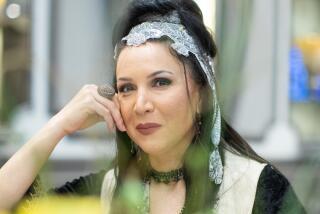Behind The Scenes : Clothes and Jewelry of Afghanistan Modestly Speak the ‘Language of Exotic Fashion’
- Share via
Seeing the elaborate clothes and jewelry from Afghanistan at the Bowers Museum of Cultural Art in Santa Ana, a viewer would think Sadiq Tawfiq was joking when he described the items from his native land as “very simple, very plain.” But that’s what he told 50 attendees at the “Language of Exotic Fashion” show and lecture Sunday.
Tawfiq, owner of Kyber Pass Gallery in Laguna Beach, was not striving for humor as he explained the meaning and purpose of each elaborately made outfit and accessory during the two-hour event.
Before a setting of a typical Afghan living area, models paraded in beautiful pieces worn by the tribal folk of the Nooristan, Turkoman, Uzbekistan and Baluchistan regions.
Though many of the pieces presented were more than 100 years old, they seemed modern. Afghan fashion itself is a melange of influences, a result of its long history of invasions from Persia, Turkey, Greece, Russia and other countries.
The most recent piece was the Russian-inspired wool Freedom Fighter hat worn by men and women in a mark of unity during the long and recent war against the former Soviet Union. An antique dowry necklace featured a cross motif, but the symbol in this Islamic country has long been purely fashionable, left over from a Christian invasion centuries ago.
Tawfiq, who immigrated to this country 13 years ago, has spent much of his life collecting cultural artifacts of Afghanistan.
Afghan women wear jewelry as adornment and for its symbolism. Sterling silver is preferred as a metal of modesty. Agate is believed to bring good luck and protection; lapis lazuli is considered to bear healing powers.
Exquisite though the jewelry may be, much of it is worn daily, Tawfiq said, even among those toiling in the fields.
Clothes, too, seemed too beautiful for the hard daily life of this mostly agrarian nation. Long gowns and chapens (dusters) of cotton and rayon are ornately embroidered with silk. During her lifetime, Tawfiq said, a woman may own only three dresses. Each is made with plenty of yardage and is embellished with embroidery or silver pieces as a remembrance of special events.
In some cases women wear a perde-- a drab robe that covers everything--but underneath they wear elaborately embroidered gowns and jewelry. “Clothing is very personal in this way,” he said.
A man only wears jewelry at his wedding, Tawfiq said. When married, men don white, and women enjoy rich shades of purple, green and fuchsia.
For centuries, clothes and jewelry have been passed from generation to generation. But, Tawfiq noted, the recent war destroyed much of the legacy and makes it difficult to carry on the craftsmanship.






